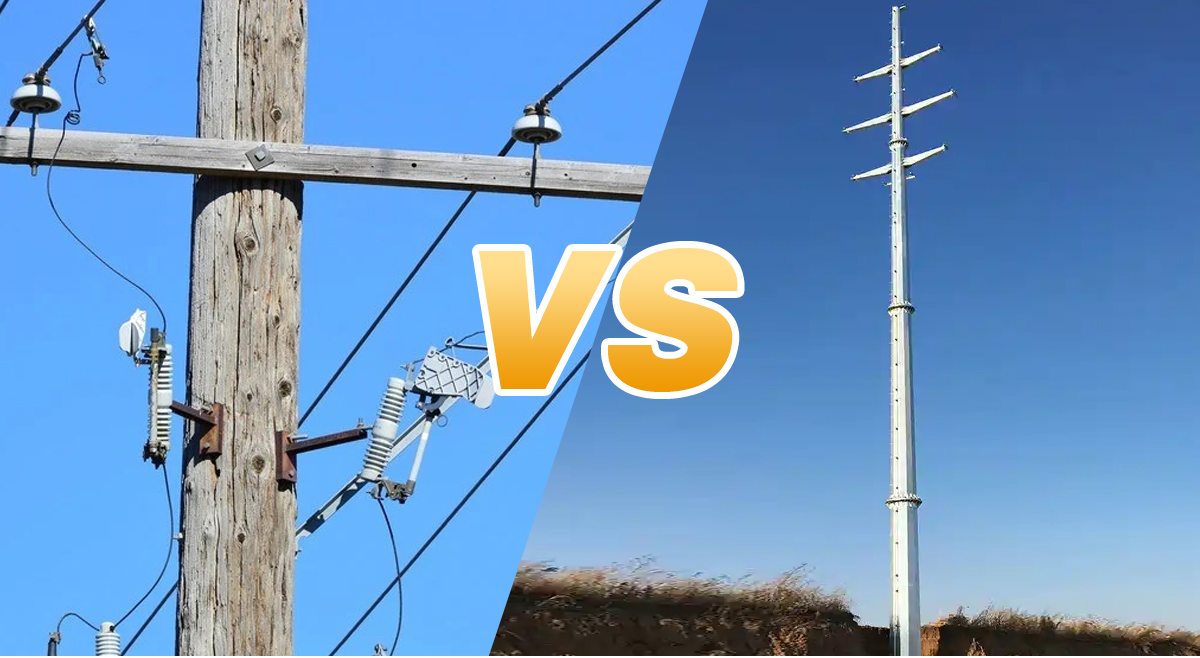In the world of electric power infrastructure, the choice of pole material is a critical decision that impacts safety, durability, and maintenance. The most commonly used materials include steel and wood. While wood poles have been the traditional choice for decades, steel poles are becoming increasingly popular due to their many advantages, especially in terms of safety. This article takes an in-depth look at the comparison between steel poles and wood poles, focusing on why steel is the safer choice.
Electrical poles basics
Electrical poles are the backbone of the power distribution system, supporting overhead wires and ensuring the safe transmission of electricity. Traditionally, wooden poles made from tree species such as cedar, pine, or fir have been the preferred choice of utility companies. However, as the demand for more resilient and safer infrastructure continues to grow, there is a shift towards steel electrical poles.
Safety hazards of wooden poles
Although low-cost and ubiquitous, wooden poles present many safety risks. One of the main issues is their susceptibility to environmental factors. Over time, wooden poles can rot, bend, or become infested by pests such as termites. These conditions can compromise the structural integrity of the poles, leading to potential failures that can cause power outages or, even worse, electrical accidents.
Additionally, wooden poles are more susceptible to fire. In areas prone to wildfires, wooden poles can easily catch fire, posing a significant risk to both electrical infrastructure and surrounding communities. When wooden poles are damaged or compromised, the risk of electrical fires is heightened, leading to dangerous, life-threatening situations.
Advantages of steel electrical poles
In contrast, steel electrical poles offer a range of safety advantages that make them a great choice for utility companies. One of the most notable is their durability. Steel poles are resistant to rot, insect damage, and extreme weather conditions, ensuring a longer service life and lower maintenance costs. This durability means fewer failures and power outages, which improves the overall reliability of the grid.
Steel poles are also less likely to catch fire than wooden poles. Should a fire occur, steel can withstand higher temperatures without compromising its structural integrity. This property is particularly important in areas susceptible to wildfires, where the risk of fire in electrical infrastructure is of great concern.
Enhanced structural integrity
Another key safety aspect of steel electrical poles is their enhanced structural integrity. Steel poles can withstand higher wind loads and are less likely to bend or break under stress. This resilience is critical in areas susceptible to severe weather such as hurricanes or blizzards. The ability of steel poles to maintain their shape and strength in adverse conditions greatly reduces the risk of accidents and injuries associated with downed power lines.
Additionally, the steel electrical poles can be designed to meet specific engineering standards, allowing for greater customization based on the environmental conditions at the installation site. This adaptability ensures the poles can handle the unique challenges presented by the surrounding environment, further improving safety.
Environmental considerations
While safety is paramount, environmental factors also play a role in the debate over steel vs. wood poles. Wood poles require felling trees, which can contribute to deforestation and habitat loss. In contrast, steel poles can be manufactured from recycled materials, making them a more sustainable choice. Steel production is also more environmentally friendly in terms of the life cycle of the materials involved.
Cost impact
One of the arguments often made in favor of wood poles is their lower initial cost. However, in the long run, steel poles may be more economical. The reduced maintenance costs, longer life, and enhanced safety of steel poles can result in significant cost savings in the long run. Utilities must weigh the initial investment against the potential costs associated with wood pole incidents, outages, and maintenance.
In conclusion
In summary, while wood poles have been the traditional choice for power infrastructure, the advantages of steel poles cannot be ignored, especially when it comes to safety. The durability, fire resistance, and structural integrity of steel poles make them the best choice for utilities to provide reliable and safe power distribution. As the demand for safer and more resilient infrastructure continues to grow, it is clear that steel electrical poles are not only a trend but an inevitable development in the field of electrical engineering. By prioritizing safety and sustainability, utilities can ensure a more secure future for their communities.
Post time: Nov-22-2024





